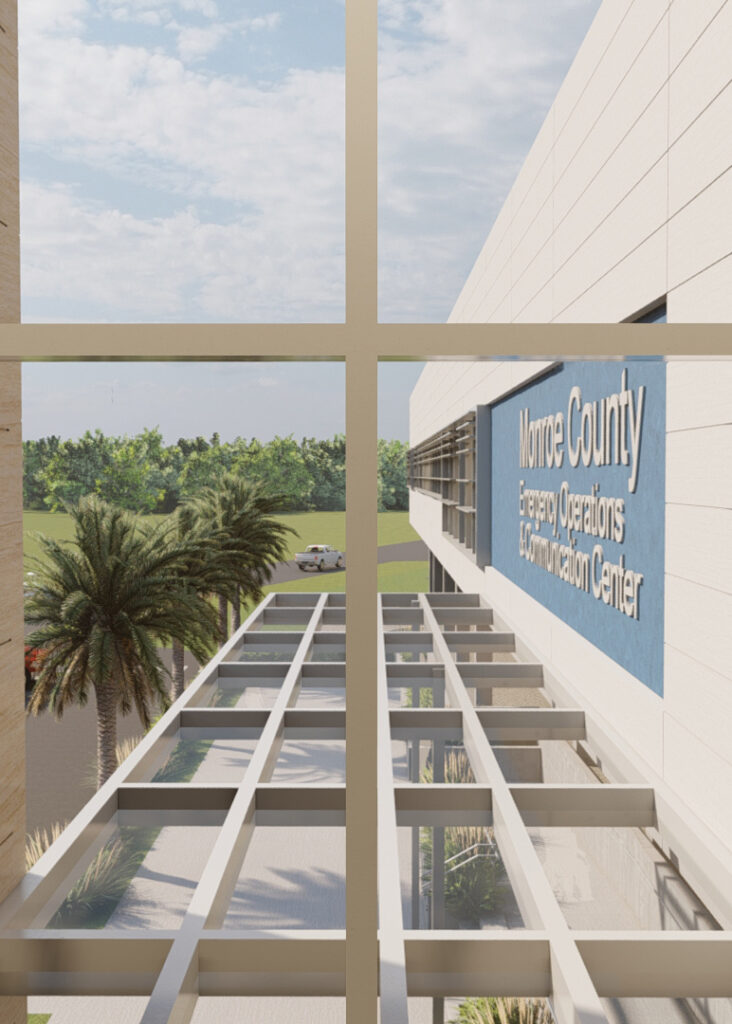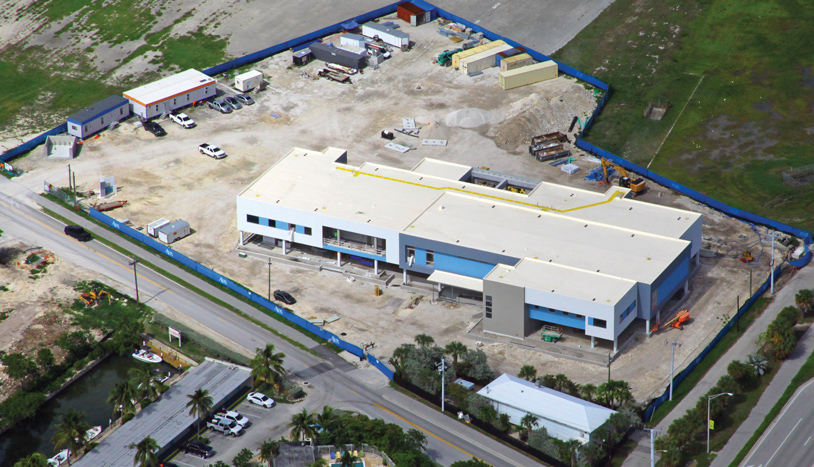Wildfires, hurricanes, tornadoes, flooding—as severe weather becomes the norm, how are high-risk communities preparing for the worst?
From unprecedented high temperatures to devastating wildfires, the summer of 2023 brought on some of the most extreme weather we’ve seen in decades. As local government grapples with what seems to be the new norm, the role of emergency operations centers (EOCs) has become even more critical to communities around the globe. With decades of experience building EOCs throughout Florida and Georgia, Ajax Building Company explains the how these critical buildings are designed, built, and operated.
EOC FUNCTION
An Emergency Operations Center is a facility designed to assist in an emergency. Depending on the region and risks, these structures are purpose-built to get the community it serves back to normal as quickly as possible. During “activation,” or the EOC’s response procedures during a potential emergency event, representatives from private and public entities come together to manage the many aspects of an emergency situation. From the power and communication companies to medical services, the fire department, and law enforcement, it’s an all-hands-on-deck approach to help the community recover.
“The people who operate out of these facilities are the boots on the ground in an emergency,” says Bill Byrne, CEO of Ajax. “The role of an EOC is to help them facilitate a return to normal, so getting businesses back up and running, getting people back in their homes, and getting kids back in schools.
TAILORED SOLUTIONS
From multidisciplinary command centers and 911 dispatch to independent data centers and media-focused areas with remote connections, the services required to streamline an emergency response while maintaining communication between officials and residents can be extensive. So, what determines the kinds of services each county includes in their EOC?
The size and scale of each county’s EOC depends on a few factors, but two primary considerations are the size of the community the EOC serves and the kinds of threats it faces. In Florida, hurricanes are typically the biggest concern, but in communities like Monroe County, which includes the islands of the Florida Keys, extreme tidal surge and flooding are also serious risks.

“Every county has a different perspective of what they need to get out of their emergency operations center,” says Jordan Wise, Ajax operations manager. “Monroe is a smaller county by comparison to middle of the state, but their EOC project has been more complex due to the area’s environmental factors.”
An EOC’s day-to-day function also depends—some municipalities may opt to run their entire sheriff’s department out of their EOC, and those buildings operate much like a typical office building would outside of activation. Others may house just 10 to 15 employees outside of activation, and as many as 200 professionals during an emergency event.
MASTERING COMPLEXITY
Building these integral structures is no walk in the park but having been involved in some of the most complex and active EOCs in the state of Florida, Ajax is well versed in the types of construction challenges that may accompany an EOC project.
Security clearance, for instance, is always a complication when an EOC houses a law enforcement agency because the building will require access to Criminal Justice Information Systems (CJIS). Workers need special security clearance just to be in the room where CJIS ties into the building, meaning the sequence of work activities must be coordinated with the level of security required of any given area.
“When we did the St. Petersburg Police Department, we built the structure and installed the skin, but once we started working inside the building, every worker had to have a certain level of security clearance to work anywhere near the building,” Byrne explains.
Air conditioning is another common challenge. These facilities operate with a lower number of occupants day to day, but the buildings’ systems must be able to effectively cool the space and bring in enough fresh air for the maximum number of occupants the EOC can accommodate during an activation. The solution: a staged air conditioning system with different sized chillers that’s able to operate in one mode during “blue skies” and another during an activation. To balance the system and preserve the equipment, building controls will exercise the chillers occasionally and make sure they’re all operating correctly.
THE EXTRA MILE
While these are common challenges for EOC construction, no two EOC projects are the same—and the Monroe County EOC is the perfect example.
After the Keys endured a direct hit from Category 4 Hurricane Irma in 2017—the worst storm the county has experienced in more than 500 years—the Monroe County Emergency Management department resolved to improve the county’s emergency management program. This plan included the construction of a nearly 30,000sf EOC facility that is designed to the highest risk (Risk Category V) and exposure (Category D) categories.

Featuring a double-layered roof membrane and ICC-500 rated exterior doors and windows, the structure will be able to withstand winds of 220mph. With two 500kW generators—each with 330 gallon day tanks— and a 2,500 gallon extra tank and connection for a third mobile generator, the EOC will be able to run completely independently for up to 96 hours.
Located on airport property, the Monroe County EOC will be perfectly positioned to receive resources during an emergency. However, the strategic location also means Ajax must comply with strict FAA regulations during construction. Complicating matters further, the entire building sits 17ft above the ground—14ft above the base flood elevation.
“We’re elevating the building, but we also have about a hundred planes flying over a corner of our jobsite every day, so we were limited on crane heights,” says Marshall Quarles, Ajax senior project manager. “We had to increase the capacity of the crane so it wouldn’t have to boom up as high when lifting the concrete panels and equipment, and adjusted our crane path so it would be as close to the building as possible.”
The project is targeted to be complete in the spring of 2024. Once it’s operational, the EOC will house Monroe County’s emergency management staff, 911 dispatch, and fire department regularly and will be able to accommodate up to 150 people during activation.
“It’s not easy to express in words the impact or importance of having a system to deal with crisis. The EOC is giving a worker a sledgehammer when all they had before was a rock,” says Cary Knight, director of project management in Monroe County Florida. “It’s a critical tool that helps the people accomplishing our mission in a safer and more efficient way. The better the response, the more lives we can save and the quicker the community can transition into recovery.”
